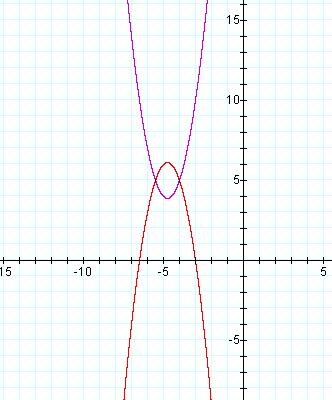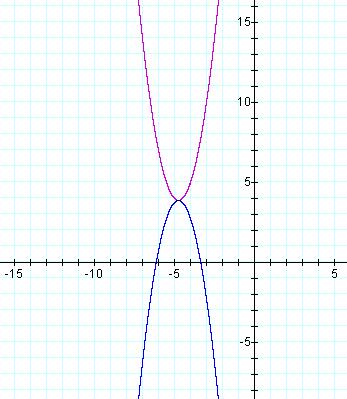
Assignment 2
An Extension of Problem 6
Making Predictions about Parabolas
by Margaret Trandel
Let's first take a look at the parent graph of a quadratic function:


To review, this graph is an upward opening parabola with the vertex at the origin. The domain all real numbers and the range only includes real numbers which are greater than or equal to zero.
Now let's modify the equation and take a look at the representation:


The graph above, as you can see, has a vertex of (-.75, -5.125) and a y intercept at (0, -4). the basic shape of the graph changes as well. The new graph is narrower than the parent graph, but is still upward opening.
Let's now replace each x in the equation with (x-4) and make a conjecture about the new graph. The new graph is in red on the axes below. The graph in blue is y = 2x squared + 3x- 4. How does your prediction compare to the representation below?


Note that after the substituion, the graph is shifted four units to the right. The vertex is now located at (3.25, -5.125). The vertex lies in the fourth quadrant. Any ideas on how we can adjust the equation to move the vertex into the second quadrant? At this point, play around with the equation on your graphing calculator, while I do the same.
What did you come up with? My first guess was to change the (x - 4)'s to (x + 4) 's. The resulting equation and graph are found below.


The graph shifted to the left, which is what I expected, but I forgot to move the graph vertically. Let's replace the -4 with a +5 and see what happens.


Yea, it works. I've successfully moved the vertex from the fourth quadrant to the second quandrant by changing the constant value from -4 to +5, and the (x - 4)'s to (x + 4)'s. It looks like the values in the equations such as -4 and 5 which are not connected to the argument (x) result in moving the graph vertically and the values which are directly connected to the argument result in a horizontal shift. It's interesting to note that a +5 moves the graph in a positive direction yet the (x +4 ) moves the graph in negative horizontal direction. Can you explain why this happens? Many students predict the direction of the vertical shift correctly, but are quite surprised about the horizontal movements of the quadratic graphs.
Let' try to transform the graph of


one more time by writing the equation for a graph which would share the same vertex ( ) as our equation above but open downward.
Any ideas? At this time, without looking below, why don't you on your own try to create a graph which shares a vertex with the graph above.
NO PEEKING!!!!!!
My first hunch was to replace the x squared coefficient of 2 with -2. I remembered that a negative x squared coefficient results in flipping the graph in the x direction. This is the graph I created.



The orientation is exactly what I am looking for, along with the x coordinate of the vertex, however, the y coordinate of the vertex is off. It looks like I need to move the graph down to meet our goals of: concave downward and matching vertices. Let's go:



Hurray! This is the formula that worked. Is this what you arrived at too?
I hope you have enjoyed this activity. Please e-mail me if you have any questions or comments.